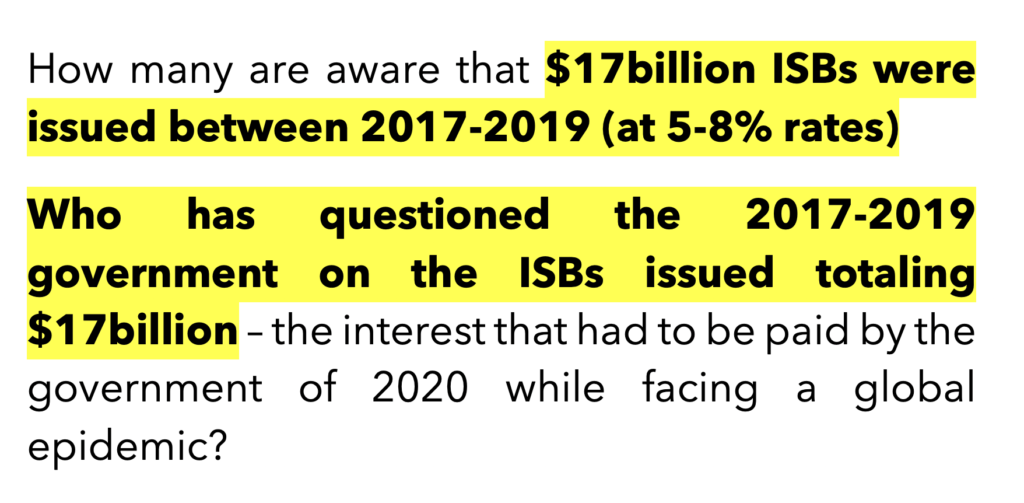What or who are the cause of Sri Lanka’s “DEBT”

It is unfortunate that even the “educated” in Sri Lanka have exposed themselves for their lack of knowledge in understanding the reasons for Sri Lanka’s debt. That they continue to view issues from political colours is disappointing. That the youth have been given a wrong impression of the debt situation on account of listening to them is equally disappointing. How many truly understand that our plight is a result of embracing open economy, while abandoning the local manufacturing entities that existed and not developing these making use of the open economy and formulating a plan to raise development in a structured way & instead falling prey to living luxurious lives falling into debt & happily taking more loans and loans & not bothered about the eventual outcome – this is what has led to the abysmal situation Sri Lanka is in. Those that take debt, those that enjoy the luxuries appear not to be bothered because it is the middle class & poor as well as the nation that has to eventually pay for it. This is the sad reality.
Did you know that International Sovereign Bonds come with high interest rates?
How many are aware that $17billion ISBs were issued between 2017-2019 (at 5-8% rates) while also amending the foreign exchange act allowing local businesses to park their profits overseas? Was this amount intentionally taken to put the successive government into difficulty politically & economically?
According to Advocata – 36% of the ISBs were subject to collective action clauses making restructuring impossible for debtor governments.
Who announced debt default?
Present Governor who had been in the Central Bank through successive governments & then Finance Minister Sabry with Parliament clueless about the announcement. What was the reason for them to declare debt default without even going to creditors & negotiating with them?
Was the environment set for default & ouster of a President?
Did companies intentionally make items unavailable to create panic? Weren’t these companies at the helm of the aragalaya? Was there something more to the gas cylinder explosions? Were the petrol queues made to force the Govt to exhaust its reserves putting it into further difficulty? Were the blackouts a means of sabotage by some within? Were street protests funded?
How many are aware that since 1978 Sri Lanka’s expenses have been more than revenue, imports more than exports & to bridge the gap governments have been taking LOANS? People kept quiet because so long as their needs were provided, that the loan was increasing didn’t bother them.
Now the greater share of external debt is borrowed from international capital markets at high interest rates.
Who was responsible for taking ISBs and committing to high interest rates?
Why ISBs? ISBs are not linked to projects – so what was done with this money as there is little transparency on how it is spent.
Who has questioned the 2017-2019 government on the ISBs issued totaling $17billion – the interest that had to be paid by the government of 2020 while facing a global epidemic?
Who was the Prime Minister & Governor who approved the ISBs?
2010 – 2021 – ISB share of Sri Lanka’s external debt went from 12% to 36%
2021 – ISBs accounted for 70% of government’s interest payments (which ate into foreign reserves) was this not the reason why the then government could not function?
Why wasn’t this situation conveyed to the people?
Who prevented the President from making public the real status quo?
ISBs are tradable & credit rating agencies know how to manipulate to downgrade countries to bring down the price of country bonds leaving country’s in vulnerable situations – taking more debt at higher interest rate to pay back outstanding obligations borrowed at lower rates.
Sri Lanka has not fallen for China debt trap – Sri Lanka is a victim of ISB debt trap.
Sri Lanka is a victim – it has a high share of ISB outstanding debt for which it must pay greater annual interest.
One of Sri Lanka’s ISB holders – Hamilton Reserve has even sued Sri Lankan Government.
Sri Lanka is facing a serious problem. How is it going to increase its reserves to ensure a steady supply of essentials (fuel/essential food/fertilizer etc) No one is looking at solutions to this issue.
IMF is no bail out.
IMF will only enable Sri Lanka to take more loans. Taking more loans means once again committing to more interest & increasing the loans.
Alongside this Sri Lanka has agreed to increase taxes, private state entities & opening doors to take more from international markets (again increasing debt) – is this a solution? – did this solution not fail and is the reason for the current default?
For a meagre $2.9b to be given in tranches – this hardly covers Sri Lanka’s annual fuel cost.
Sri Lanka’s annual debt servicing is $4.5billion.
It’s a pity Sri Lanka’s corporate community is silent having parked its $53billion profits overseas & not even considering negotiating with the government to facilitate the $2.9b that Sri Lanka sought from IMF with severe conditions that are slowly impacting on the people while keeping the politicians and corporate elite happy.
The moral duty of the corporate community in Sri Lanka has been exposed by their silence preferring to watch SOEs be privatized & lining up to become local partners of the foreign governments/companies bidding for these state entities. It has exposed that their profits matter more than being conscious citizens to come forward to help the State when in need, at least for the sake of the citizens.
Shenali D Waduge







